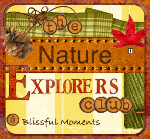
Welcome to The Nature Explorers Club. I am a mom who loves nature and loves to share it with others. Using my experience as an Outdoor Education Instructor and the basic guidelines of the book "Nature For the Very Young", I will be venturing out to explore the great outdoors every week with my kids. Every week I will share what we did, and every week you are welcome to join us. I will post the topic of the week, then two weeks later I will share what we did and give you a chance to share as well. So get your boots ready, because we're going exploring!
**I just published the post and all my pictures disappeared, sigh....it is almost midnight so I will return again tomorrow and try to fix the pictures - Jen
This week's topic.....
Habitats
This weeks topic is very simple, yet complicated at the same time. Most children already have a sense of the differences between habitats, they just have never labeled them with the word "habitat". A habitat is quite simply the place where a plant or animal lives. What makes the habitat so special is that it provides things that are needed for the animals and plants to survive like food, water and shelter.
As you begin to talk to your children about habitats it may be easier to use your own home as your first example. Talk about your home and why you live there. It keeps you dry when it rains, it has a refrigerator and running water. You can ask them if they could live in a pond, and maybe why that may not be a good idea. It is ok to interchange the word "home" and "habitat" until your children have a good grasp of what you mean.
After discussing their own "habitat" you can go outdoors and explore other habitats like a forest, pond, swamp, or field. Wherever you go, make sure to first let them explore and see what they can find. Encourage them to look under and around things, to touch with caution (poison ivy is not your friend), but above all to be gentle with nature.
Take some time to sit and use your other senses. What does this particular habitat smell like. Close you eyes, do you hear anything? While you are sitting there, do you feel anything? Is is hot, cold, is there a breeze?
Discuss the different animals that live in the habitat, and why they live there. There are several animals that can live in more than one habitat. An example is snakes. You can find them in a field, the forest, a swamp and on the edge of a pond. Don't forget to mention some of the smallest of creatures including ants, worms, caterpillars and flies. These can be found almost anywhere.


Try to explore more than one habitat so that you children can experience the differences and similarities between different habitats. Have the children collect one thing from each habitat to bring home that most reminds them of what they saw. This can become a very special time where everyone can share why they chose what they chose.
This weeks topic is more about the experience gained than the information retained. Don't be worried if there is lots of exploring and few questions. Children learn so much by looking and touching. If they ask questions, by all means answer, but overall this should be a time of gathering new experiences.
Activities:
Please note that all activities that are italicized are directly from the book, "Nature For the Very Young"
*Draw pictures of the different habitats. For the younger ones, have them tell you what they saw as you draw, or have them draw their own version, how ever sqribbly it is.
*Cut pictures out from magazines, or print some from the internet and using the pictures you drew, place them in the appropriate habitat
*Take the time to explore one of the habitats at night. It is amazing how different things are by the moonlight.
*Play a game of charades, where you name a habitat and everyone takes turns acting out an animal found in that habitat while everyone else tries to guess what it is.
*Read book s from the "One Small Square " series of books.
*Make scavenger hunt lists for your local habitats.
*Play "Habitat Bingo" - this is my own version of bingo using different habitats. I attempted all night to attach the files, but was not successful. If you click here, it should take you to a place where you can access the files. If this doesn't work, just e-mail me and I will give them to you. It uses full color images of different animals and plants that can be found in five different habitats, field, forest, swamp, pond and ocean.
To play: each person gets one game board. Place the cut out game tiles in a pile or in a bag. Take one out one at a time. If the plant or animal is found on your game board, cover it up. (you can use anything like beans or pennies to do this) The first person to get five in a row wins.
*Compare two habitats and what was the same and what was different between them.
*Have them create their own animal and make a habitat for it. You can use crayons and paper, magazines and glue or you go 3-dimensional and use clay or things from your recycle bin.
Pick and choose which activities best fit with your home. Don't be afraid to try something different if it interests you. Remeber to come back in two weeks and share what you did. See you then!















